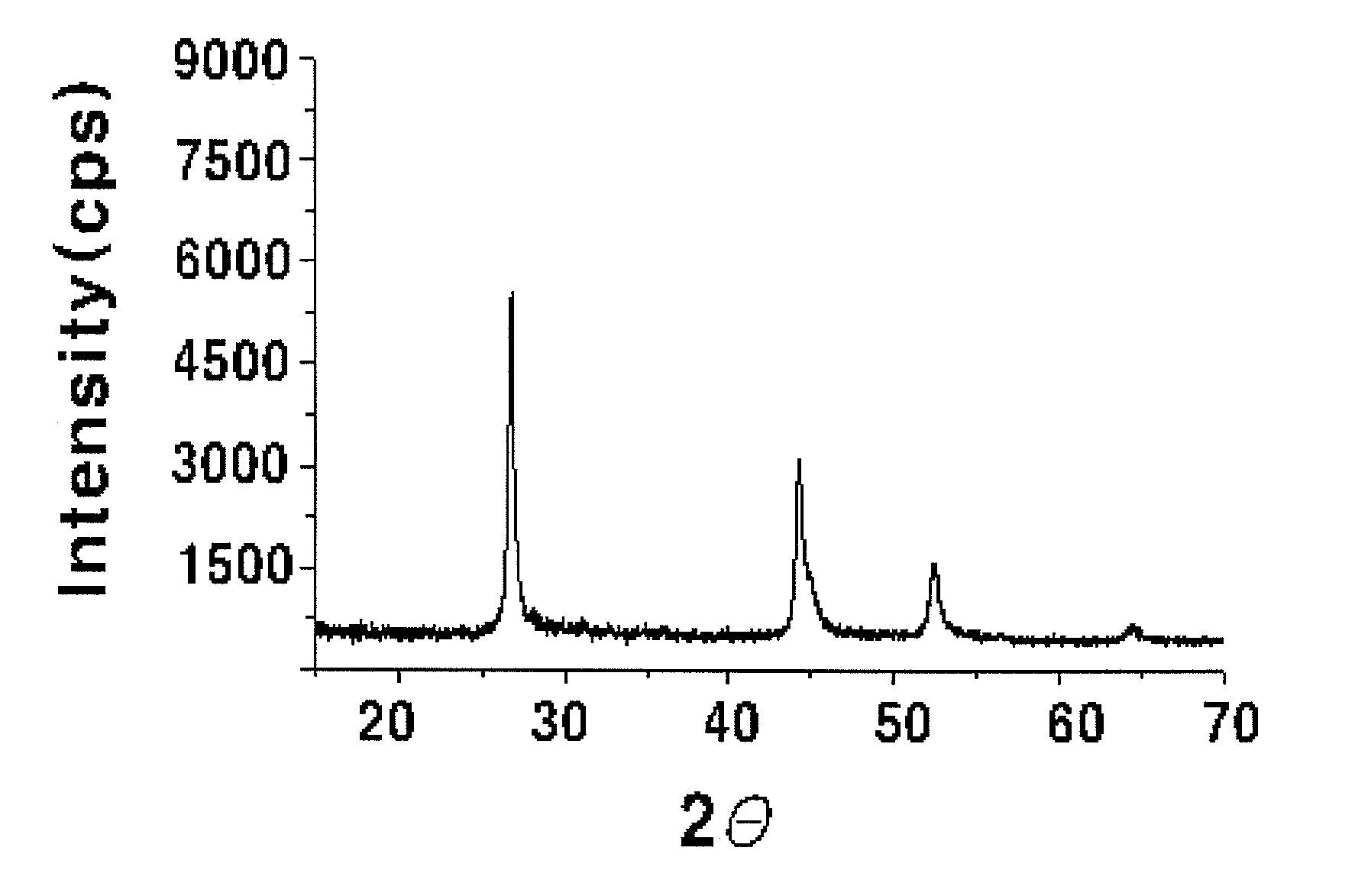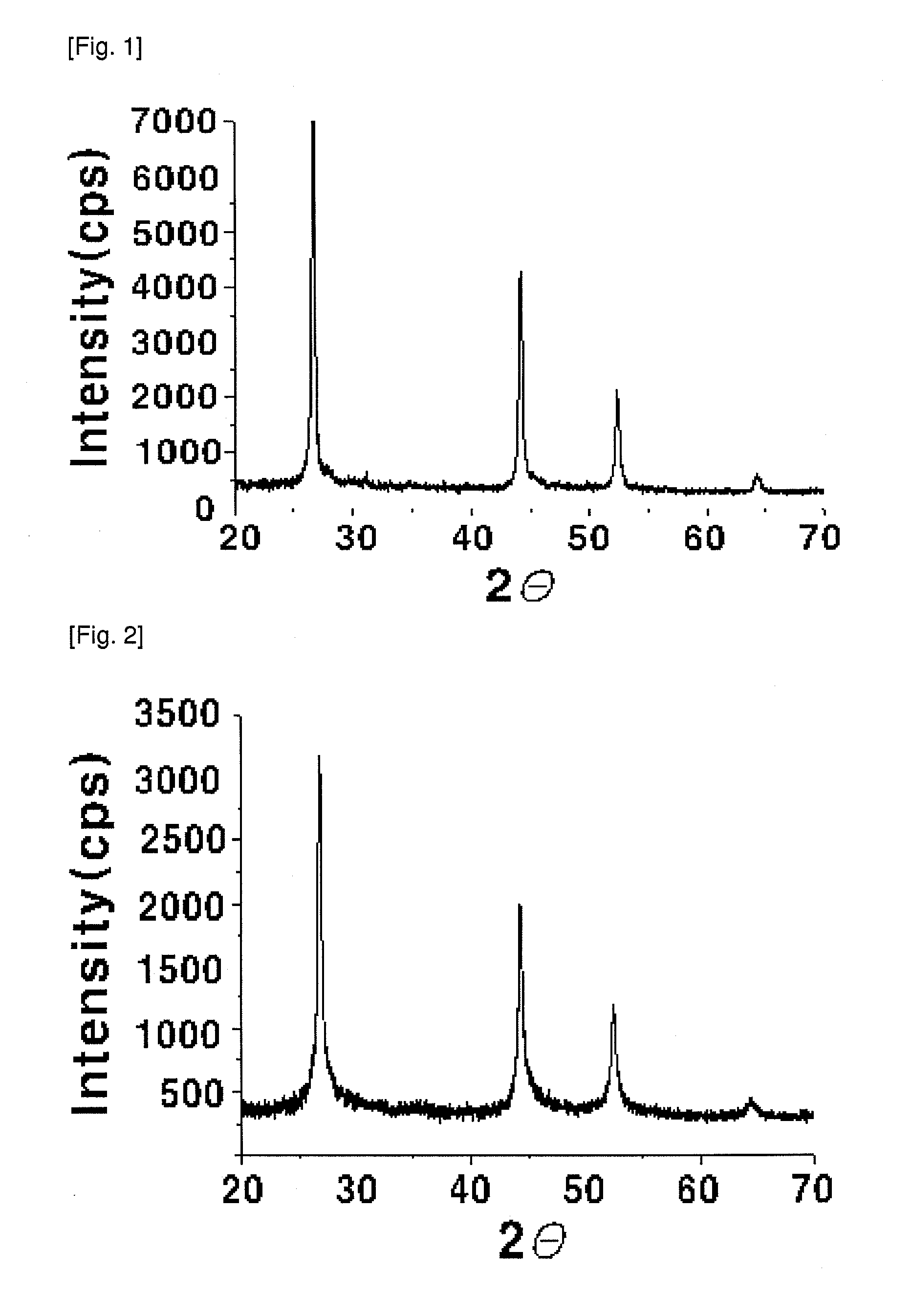Preparation method of chalcopyrite-type compounds with microwave irradiation
a technology of chalcopyrite and microwave irradiation, which is applied in the field of preparation of chalcopyrite-type compounds, can solve the problems of long reaction time, high energy cost, and high equipment and energy cost, and achieves short reaction time, low equipment and high energy cost.
- Summary
- Abstract
- Description
- Claims
- Application Information
AI Technical Summary
Benefits of technology
Problems solved by technology
Method used
Image
Examples
example 1
[0044]4 g (29.75 mmol) of copper dichloride (CuCl2), 8.8 g (30.01 mmol) of indium trichloride (InCl3 4H2O) and 4.74 g (60.03 mmol) of selenium powder were added to 500 ml of a mixed solution of ethylenediamine (ED): ethanol (E) (ED:E=3:1 molar ratio). The mixture was introduced into a microwave reactor (CEM, Model Mars-5), from which oxygen has been removed by purging with nitrogen under a nitrogen stream, and was irradiated with microwaves having a frequency of 2.54 GHz to elevate the reaction temperature to 140° C., and the mixture was maintained at autogeneous pressure (about 4 atm) for 5 minutes, so that the mixture in the reactor was allowed to react. Then, the reaction product was cooled to room temperature, centrifuged, washed with ethanol and distilled water, and dried in a nitrogen atmosphere at 80° C., thus preparing a chalcopyrite CuInSe2 compound. The X-ray diffraction pattern of the synthesized powder was analyzed (Rigaku Japan, D / max-A, CuK:=1.54178 Å) and, consistent ...
example 2
[0046]4 g (29.75 mmol) of copper dichloride (CuCl2), 8.8 g (30.01 mmol) of indium trichloride (InCl34H2O) and 4.74 g (60.03 mmol) of selenium powder were added to 500 ml of ethylenediamine (ED). The mixture was introduced into a microwave reactor (CEM, Model Mars-5), from which oxygen has been removed by purging with nitrogen, under a nitrogen stream, and was irradiated with microwaves having a frequency of 2.54 GHz to elevate the reaction temperature to 180° C., and the mixture was maintained at autogeneous pressure (about 3.5 atm) for 30 minutes, so that the mixture in the reactor was allowed to react. Then, the reaction product was cooled to room temperature, centrifuged, washed with ethanol and distilled water, and dried in a nitrogen atmosphere at 80° C., thus preparing a chalcopyrite CuInSe2 compound. The X-ray diffraction pattern of the synthesized powder was analyzed (Rigaku Japan, D / max-A, CuK:=1.54178 Å) and it was found to be consistent with JCPDS No. 89-5647 (FIG. 2).
[00...
example 3
[0048]4 g (29.75 mmol) of copper dichloride (CuCl2), 4.398 g (15.00 mmol) of indium trichloride (InCl34H2O), 1.046 g (15.00 mmol) of Ga and 4.74 g (60.03 mmol) of selenium powder were added to 500 ml of ethylenediamine (ED): ethanol (E) (ED:E=3:1 molar ratio). The mixture was introduced into a microwave reactor (CEM, Model Mars-5), from which oxygen has been removed by purging with nitrogen, under a nitrogen stream, and was irradiated with microwaves having a frequency of 2.54 GHz to elevate the reaction temperature to 180° C., and the mixture was maintained at autogeneous pressure (about 4 atm) for 5 minutes, so that the mixture in the reactor was allowed to react. Then, the reaction product was cooled to room temperature, centrifuged, washed with ethanol and distilled water, and dried in a nitrogen atmosphere at 80° C., thus preparing a chalcopyrite CuIn0.5Ga0.5Se2 compound. The X-ray diffraction pattern of the synthesized powder was analyzed (Rigaku Japan, D / max-A, CuK:=1.54178 Å...
PUM
| Property | Measurement | Unit |
|---|---|---|
| temperature | aaaaa | aaaaa |
| pressure | aaaaa | aaaaa |
| reaction time | aaaaa | aaaaa |
Abstract
Description
Claims
Application Information
 Login to View More
Login to View More - R&D
- Intellectual Property
- Life Sciences
- Materials
- Tech Scout
- Unparalleled Data Quality
- Higher Quality Content
- 60% Fewer Hallucinations
Browse by: Latest US Patents, China's latest patents, Technical Efficacy Thesaurus, Application Domain, Technology Topic, Popular Technical Reports.
© 2025 PatSnap. All rights reserved.Legal|Privacy policy|Modern Slavery Act Transparency Statement|Sitemap|About US| Contact US: help@patsnap.com



